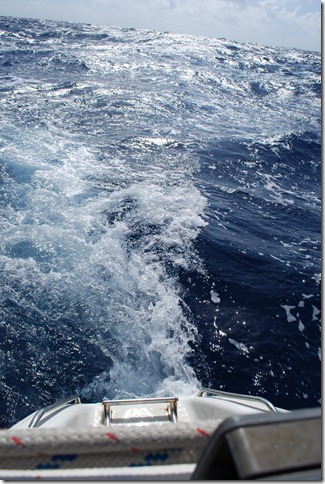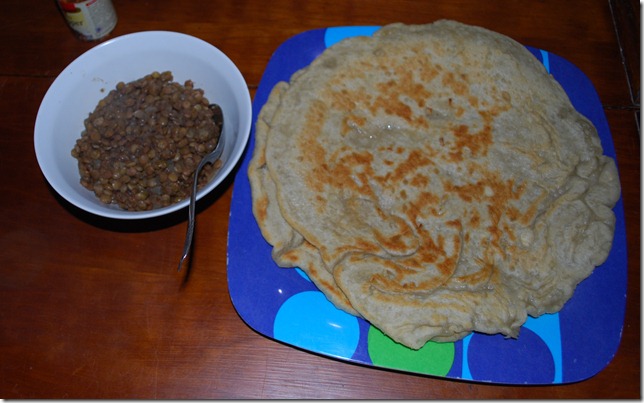Lat: 12 58.545′ S
Lon: 65 38.785′ E
Most of the time, we’re pretty happy adventuring on the other side of the world but tomorrow will be an exception. My cousin Melanie is getting married on Sunday, and while we’d love to leave the boat on autopilot, catch a passing freighter, fly to the US for the wedding, and then retrace our steps back (Pura Vida would still be sailing toward Cape d’Ambre), it would be a bit of a stretch. Tomorrow will definitely be the day I’ve most wished to be back in the states (OK, those two days of seasickness in the Caribbean are a close second). We love you Melanie, and wish you and Michael the best. We promise we’ll bring you a well-travelled wedding gift, but shipping will probably be about 8 months.
We made a couple of milestones today: we entered a new time zone (GMT+4), and we now have less than 1000 nm to the Cape d’Ambre at the northern tip of Madagascar. We’re averaging over 6 knots so far, and except for the 36 exciting hours when we had a double-reefed main up, it’s all been just the jib, which is definitely our workhorse sail. The sailmaker in Block Island, Florida definitely did right by us when he re-stitched the whole jib after we dropped it off for a small repair.
You’d think we would be going crazy about now, but we’re not. In a complete reversal of her initial reservations, Lauren is really enjoying the time out here. She was actually talking yesterday about wanting stay out here enjoying the beauty and peace (did I mention we haven’t run out of cheese yet?). I can definitely understand her perspective. The days have been sunnier lately with fewer squalls and the seas, though still large at times, aren’t as rough and confused as they were earlier in the trip. With the weather forecast calling for lighter winds the rest of the way, it’s looking like the roughest part is behind us. You might think we’d get bored out here, but we haven’t yet.
If you’ve ever been to the beach and been mesmerized by the sight of the waves breaking, then you’d probably understand how we never get tired of watching the waves. Waves on a beach are just plain boring after you’ve had a chance to watch mid-ocean waves. Beach waves are almost all the same; no matter how far they’ve travelled they all meet a similar demise, standing up and curling until they break into white water and spend the last of their energy in a flattened surge up the beach. In mid-ocean, they’re much more diverse and dynamic. Surfers have a myriad of names for the various shapes a breaking wave can take, but sailors haven’t been as creative in naming the offshore shapes. Like Lauren described in the last blog, some of the more exciting ones are fast and steep, rushing toward you, often with a foamy, breaking crest. Laying in the salon, we can see the crest of the large wave towering above the solar panels and speeding towards us. Just when you think, “Wow, this one’s going to get us” it disappears as the boat rises gracefully on the face of the wave and in a second it’s underneath us, sometimes with a slap on the underside of the bridgedeck, and in the next second it racing off toward Oman and all we can see from down in the trough is its steep back and white crest. You could go on for a while about the long, smoothed-out, slow rollers that amble in from distant storms, looking more like minor geographic features, the short, steep, squall-driven waves, the occasional steep ones from the south that slap you on the side or give you a quick knock-around by lifting one hull while dropping the other, and the big foamy ones from directly astern that gurgle like white water between the hulls while they slide underneath us. Watching them out there as they’re all superimposed, crossing paths, riding over each other, swelling up in lumps, or charging in a line makes you feel lucky to be out here.
 Leaving the Indian Ocean in our wake as we slide down a wave
Leaving the Indian Ocean in our wake as we slide down a wave
It still amazes me that we see birds every day, no matter where we are. It’s astounding to me that they can survive at such great distances from land, always counting on plucking their next meal from the sea and navigating the featureless oceans instinctively. Now that we have a radio, they’re not our only companions. Getting to talk to someone for a couple of minutes every during a net and listening to news and entertainment broadcasts really adds to the day. Unlike in the Pacific, we also see quite a few cargo ships. Most of them only show up on the AIS, and don’t come into sight, but a few have come within 2-4 miles, which is pretty close out here. We’d stopped seeing them on the AIS for a couple of days and I thought perhaps we were out of the shipping lanes that run from South Africa to Asia when Lauren sighted a ship only a few miles away that didn’t show up on AIS. I tried calling them on the radio to check the status of their AIS transmitter, but got the not so unusual no-response. After a reboot of the AIS and chartplotter, we now see ships crossing our path on a regular basis again.
The last couple of afternoons have been dedicated to repairing leaks. Both the leak in the port forward cabin and the starboard engine room turned out to have the same cause. Someone who was either ignorant or lazy beyond even my capacity for such things decided to install something by screwing mounting screws directly into the hull below the waterline instead of using more appropriate methods. The downside of drilling or screwing a hole into your boat’s hull below the waterline would seem to be obvious, but I guess it’s not enough to prevent a shortcut in some cases. A bit of underwater epoxy has stopped up the leaks, but the water damage will probably take more work to remedy in spots.
With our 12th nightfall and the customary sunset squall behind us, it’s time to enjoy a couple of treats — the now full moon rising through the scattered clouds and a delicious garlic naan Lauren just finished making. Mmmm.


